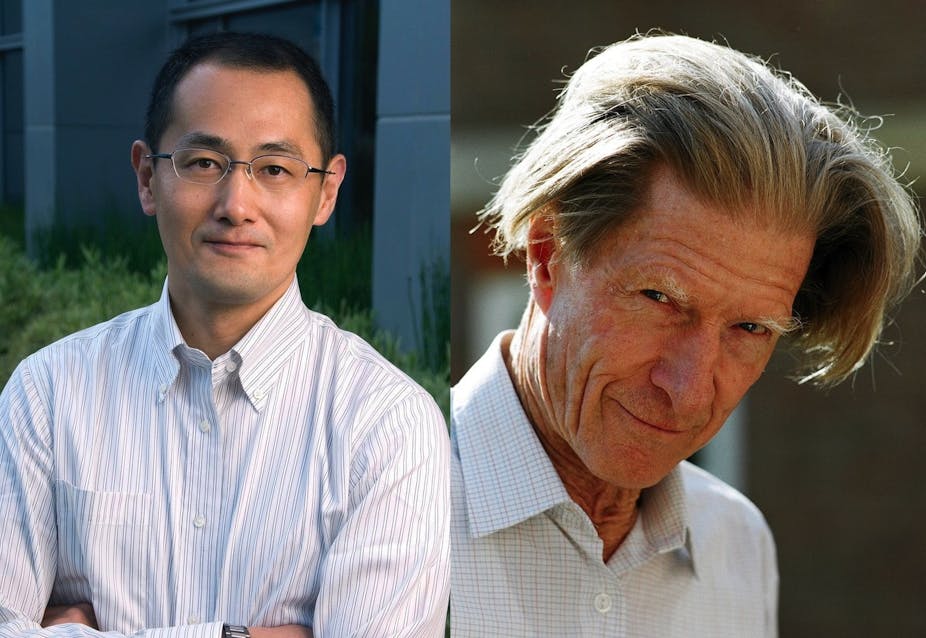The 2012 Nobel Prize for Medicine and Physiology has been awarded to John Gurdon and Shinya Yamanaka, “for the discovery that mature cells can be reprogrammed to become pluripotent”.
A pluripotent cell is capable of becoming any of the cells in the body, just as the cells of an early embryo can. When they are derived from an embryo, these cells are referred to as embryonic stem cells and they have the potential to differentiate into all cell types of the body.
John Gurdon’s contribution to this field was his foresight, in 1958, to predict that the egg, which is normally fertilised to produce an embryo, contains powerful factors that regulate the way genes are expressed during very early development.
Gurdon used nuclei from mature frog cells to show that these nuclei were capable of being reprogrammed to a “naïve” state by frog eggs – so much so that they gave rise to a live offspring. What had actually happened was that the egg managed to wipe off specific marks present in the cell’s nuclei that enable them to perform specific functions, making the cell pluripotent and able to differentiate into all cell types of the body.
Gurdon’s work opened up a whole new field in developmental biology, which we call epigenetics. This involves the study of how the expression of genes is regulated. Some epigenetic factors silence genes so that they are not expressed, while others promote the expression of genes.
It enabled us to start understanding the importance of the timing of the expression of certain genes during development, and the whole sequence of gene expression, which determines how we develop. We now apply this knowledge to differentiating embryonic and induced pluripotent stem cells to understand when a mutation might have its first effect on an individual during development, and how it might predispose people to certain diseases.

But it wasn’t until 1997 that one of the major advances resulted from Gurdon’s work. This was the cloning of Dolly the Sheep. Here, Keith Campbell and Ian Wilmut took a cell from a sheep mammary gland (breast tissue) and introduced the cell into a sheep egg. This resulted in Dolly, the first mammalian clone. Since then, multiple species have been cloned and the cloning industry has expanded to produce specialised livestock for agricultural purposes.
Scientists also wanted to know whether it was possible to derive human embryonic stem cells using this approach, where the cell to be reprogrammed would, for example, contain mutations associated with specific human diseases. This was considered to be a holy grail for scientists as it would provide human models of disease that are so desperately required for medical research. Sadly, this has proven to be elusive to date.
Although this is exciting work, cloning opened up a whole world of controversy. Research governance bodies such as the Human Fertilisation and Embryology Authority in the United Kingdom and the NHMRC in Australia had to rethink whether they should allow people to do this sort of work using human cells and human eggs.
Nevertheless, a major breakthrough came when Shinya Yamanaka deciphered which of the key factors present in the egg conferred pluripotency. He chose four genes that, when packaged appropriately and then incubated with cells, such as skin cells, had the potential to reprogram or de-differentiate these cells into pluripotent stem cells. Remarkably, this technique did not require the use of an egg to generate these embryonic-like stem cells and became known as induced pluripotency.
Yamanaka then showed that these cells could be differentiated into many of the cell types of the body, such as nerve and heart cells. Since then, others have made induced pluripotent stem cell lines of various diseases including Parkinson’s disease.
The modification of DNA and how genes are expressed is not just limited to developmental biology. These scientists have allowed us to think differently about how, for example, cancers arise. Some of the factors involved in inducing pluripotency are similar to the factors involved in cancers. And this work has been instrumental for getting researchers from different disciplines to work together to find common ground and answer significant scientific questions.

This is not the first Nobel prize associated stem cell research either. Martin J. Evans, Mario Capecchi and Oliver Smithies were awarded the prize in 2007, “for the discoveries of principles for introducing specific gene modifications in mice by the use of embryonic stem cells.” Their work led to more efficient mechanisms for generating transgenic mice that may be deficient of a specific gene or have one that is over-expressed. Such mice are invaluable in medical research as they are instrumental in studying disease and for drug discovery.
There’s still the potential for stem cells to be used for therapeutic purposes, but they are equally important for helping us understand developmental biology processes and for designing therapeutics based on what we learn from them.
But this award shows how basic science is fundamentally important for opening the doors of translational research. As we drive towards translational research, we need to remember that early fundamental science is integral and we can’t do translational work without it.
Science also needs young intellects to step forward to drive tomorrow’s research programs. Giving people like John Gurdon and Shinya Yamanaka the Nobel prize for their inventiveness will hopefully switch young people on and encourage them to think into the unknown. It’s also worth remembering that John Gurdon was told by his teacher that he was not cut out for science.

